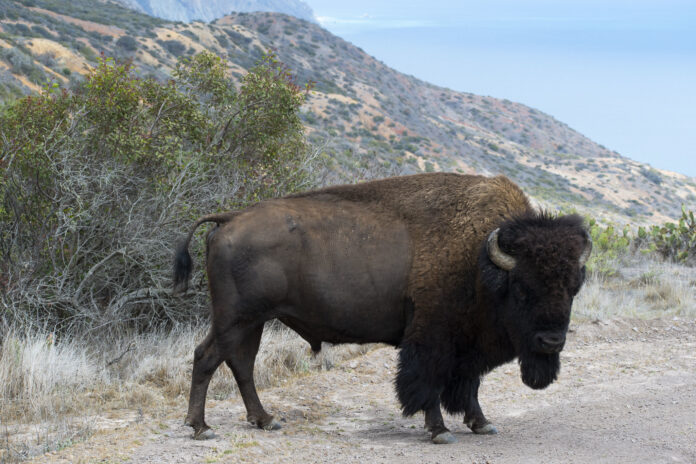
No human beings were hurt during the incident
By Charles M. Kelly
Last week, campers at Little Harbor witnessed a fight among multiple bison. Apparently, on Friday, August 19, a male bison got into a fight with a female bison and another bull. Yet another bison bull eventually participated. Heavy equipment was reportedly deployed to slow down if not disrupt the fight and campers were directed into cars or onto picnic tables.
Fortunately, no human beings were hurt.
Sadly, three of the bison drove the fourth into the water and the bull drowned.
The incident occurred as bison breeding season approaches.
This is a time when the animals may be aggressive with one another.
Although the fight was apparently videoed, the Islander found few references to the incident on social media. One Facebook post speculated that the aggressive behavior was due to the administration of hormones.
However, Catalina bison were last administered contraceptives in 2016.
After getting confirmation of the fight, the Islander receive the following information from Catalina Island Conservancy President & CEO Tony Budrovich:
Is this a common occurrence?
“The male bison normally jockey with each other to gain a position closer to the herd of cows (female bison),” Budrovich said.
The Island has more than 50 female bison that normally group together. At times the female bison split into two or three separated herds. There are two male bison who can always be found with the female herds. Most of the male bison hope to move into that spot which causes the normal end of summer pushing interactions,” Budrovich said.
Can you explain a bit about bison behavior and interactions during breeding season?
“Each of the male bison live a mostly solo life, which is typical of bison in any part of the country. Near the end of each summer, they position to try to join the female bison.,” Budrovich said.
“These interactions between males are normally a bit of positioning and pushing. Typically, one of the male bison walks away and finds a space solo of other to plan his next interaction,” Budrovich said.
How can people on the Island stay safe?
“We always suggest keeping 150’ of separation between yourself and bison. Keep aware of your surroundings. A bison fight is rare but possible to witness. Seldom do they happen near people.
“The Island’s outdoor adventure types should always be aware of the need for hydration, to avoid too much sun, bison, snakes, spiders, ants, insects, poison ivy, cactus, and the rocky surface,” Budrovich said.
“Bison have been on Catalina Island for nearly 100 years. It is rare to view bison, so people love to experience these wild animals. The bison was named the National Mammal and has a strong following by visitors,” Budrovich said.
“The Island treats bison like a conservation herd in that there is no hunting of bison, no natural predators and they live longer on Catalina Island than anywhere else in the country. We have nearly a dozen bison who have lived more than 30 years on Catalina. This is 8-10 years longer than most bison in other parts of the country. Their long history on the Island is cherished by locals and visitors,” Budrovich said.
According to an article about bison posted on the Conservancy website, “Bison can run up to 35 miles per hour, jump over fences and are good swimmers.”
According to the Conservancy website, “Bison bulls can weigh between 1,000 pounds and a ton, and stand five and a half to six and a half feet tall. Bison cows are smaller, weighing 700 to 1,000 pounds and reach a height of five feet. A bison calf can weigh 35 to 60 pounds at birth and grow up to 400 pounds in its first year.”










